Bibliometric Analysis on the Research of Geoscience Knowledge Graph (GeoKG) from 2012 to 2023
Abstract
1. Introduction
2. Materials and Methods
2.1. Research Framework and Data Source
2.2. Search Criteria and Justifications of Search Terms
2.3. Methods of Analysis
3. Results and Discussion
3.1. Trends in Publications and Citations
3.2. Top Publications, Research Areas, and Sources
3.3. Leading Authors, Institutions, and Countries
3.4. Scientific Collaboration Analysis
3.5. Keyword Analysis
4. Future Directions for GeoKG Research
- (1)
- Representation of procedural knowledge in GeoKGs.
- (2)
- Knowledge representation of geoscientific models in GeoKGs.
- (3)
- Construction of multi-modal GeoKGs.
- (4)
- Integration of Large Language Models (LLMs) and GeoKGs.
5. Conclusions and Limitations
Author Contributions
Funding
Data Availability Statement
Conflicts of Interest
References
- Hogan, A.; Blomqvist, E.; Cochez, M.; d’Amato, C.; de Melo, G.; Gutierrez, C.; Gayo, J.E.L.; Kirrane, S.; Neumaier, S.; Polleres, A.; et al. Knowledge graphs. Commun. ACM 2021, 64, 96–104. [Google Scholar]
- Zhang, X.; Huang, Y.; Zhang, C.; Ye, P. Geoscience Knowledge Graph (GeoKG): Development, construction and challenges. Trans. GIS 2022, 26, 2480–2494. [Google Scholar] [CrossRef]
- Zhou, C.; Wang, H.; Wang, C.; Hou, Z.; Zheng, Z.; Shen, S.; Cheng, Q.; Feng, Z.; Wang, X.; Lv, H.; et al. Geoscience knowledge graph in the big data era. Sci. China Earth Sci. 2021, 64, 1105–1114. [Google Scholar] [CrossRef]
- Zhu, Y.; Sun, K.; Wang, S.; Zhou, C.; Lu, F.; Lv, H.; Qiu, Q.; Wang, X.; Qi, Y. An adaptive representation model for geoscience knowledge graphs considering complex spatiotemporal features and relationships. Sci. China Earth Sci. 2023, 66, 2563–2578. [Google Scholar] [CrossRef]
- Lu, F.; Zhu, Y.; Zhang, X. Spatiotemporal knowledge graph: Advances and perspectives. J. Geo-Inf. Sci. 2023, 25, 1091–1105. [Google Scholar]
- Wang, C.; Hazen, R.M.; Cheng, Q.; Stephenson, M.H.; Zhou, C.; Fox, P.A.; Shen, S.-Z.; Oberhänsli, R.; Hou, Z.; Ma, X.; et al. The Deep-Time Digital Earth program: Data-driven discovery in geosciences. Natl. Sci. Rev. 2021, 8, nwab027. [Google Scholar] [CrossRef] [PubMed]
- Chen, J.; Liu, W.; Wu, H.; Li, Z.; Zhao, Y.; Zhang, L. Basic Issues and Research Agenda of Geospatial Knowledge Service. Geomat. Inf. Sci. Wuhan Univ. 2019, 44, 38–47. [Google Scholar] [CrossRef]
- Ma, X. Knowledge graph construction and application in geosciences: A review. Comput. Geosci. 2022, 161, 105082. [Google Scholar] [CrossRef]
- Mai, G.; Hu, Y.; Gao, S.; Cai, L.; Martins, B.; Scholz, J.; Gao, J.; Janowicz, K. Symbolic and subsymbolic GeoAI: Geospatial knowledge graphs and spatially explicit machine learning. Trans. GIS 2022, 26, 3118–3124. [Google Scholar] [CrossRef]
- Janowicz, K.; Gao, S.; McKenzie, G.; Hu, Y.; Bhaduri, B. GeoAI: Spatially explicit artificial intelligence techniques for geographic knowledge discovery and beyond. Int. J. Geogr. Inf. Sci. 2020, 34, 625–636. [Google Scholar] [CrossRef]
- Gao, S. A Review of Recent Researches and Reflections on Geospatial Artificial Intelligence. Geomat. Inf. Sci. Wuhan Univ. 2020, 45, 1865–1874. [Google Scholar] [CrossRef]
- Qian, T.; Liu, B.; Nguyen, Q.V.H.; Yin, H. Spatiotemporal Representation Learning for Translation-Based POI Recommendation. ACM Trans. Inf. Syst. (TOIS) 2019, 37, 18. [Google Scholar] [CrossRef]
- Scheider, S.; Nyamsuren, E.; Kruiger, H.; Xu, H. Geo-analytical question-answering with GIS. Int. J. Digit. Earth 2020, 14, 1–14. [Google Scholar] [CrossRef]
- Jiang, B.C.; You, X.; Li, K.K.F.; Li, T.; Zhou, X.; Tan, L. Interactive Analysis of Epidemic Situations Based on a Spatiotemporal Information Knowledge Graph of COVID-19. IEEE Access 2022, 10, 46782–46795. [Google Scholar] [CrossRef] [PubMed]
- Lu, F.; Yu, L.; Qiu, P. On Geographic Knowledge Graph. J. Geo-Inf. Sci. 2017, 19, 723–734. [Google Scholar]
- Hu, Y. Geo-text data and data-driven geospatial semantics. Geogr. Compass 2018, 12, e12404. [Google Scholar] [CrossRef]
- Wang, C.; Li, Y.; Chen, J. Text mining and knowledge graph construction from geoscience literature legacy: A review. In Recent Advancement in Geoinformatics and Data Science; Ma, X., Mookerjee, M., Hsu, L., Hills, D., Eds.; Geological Society of America: Boulder, CO, USA, 2023; Volume 558. [Google Scholar]
- Zhu, Y.; Sun, K.; Li, W.; Wang, S.; Song, J.; Cheng, Q.; Yang, J.; Mu, X.; Geng, W.; Dai, X. Comparative Analysis and Enlightenment of Geoscience Knowledge Graphs: A Perspective of Construction Methods and Contents. Geol. J. China Univ. 2023, 29, 382–394. [Google Scholar]
- Donthu, N.; Kumar, S.; Mukherjee, D.; Pandey, N.; Lim, W.M. How to conduct a bibliometric analysis: An overview and guidelines. J. Bus. Res. 2021, 133, 285–296. [Google Scholar] [CrossRef]
- Mukherjee, D.; Lim, W.M.; Kumar, S.; Donthu, N. Guidelines for advancing theory and practice through bibliometric research. J. Bus. Res. 2022, 148, 101–115. [Google Scholar] [CrossRef]
- Khare, A.; Jain, R. Mapping the conceptual and intellectual structure of the consumer vulnerability field: A bibliometric analysis. J. Bus. Res. 2022, 150, 567–584. [Google Scholar] [CrossRef]
- Li, J.; Goerlandt, F.; Li, K.W. Slip and Fall Incidents at Work: A Visual Analytics Analysis of the Research Domain. Int. J. Environ. Res. Public Health 2019, 16, 4972. [Google Scholar] [CrossRef] [PubMed]
- Liu, F.; Lin, A.; Wang, H.; Peng, Y.; Hong, S. Global research trends of geographical information system from 1961 to 2010: A bibliometric analysis. Scientometrics 2016, 106, 751–768. [Google Scholar] [CrossRef]
- Chen, X.; Xie, H.; Li, Z.; Cheng, G. Topic analysis and development in knowledge graph research: A bibliometric review on three decades. Neurocomputing 2021, 461, 497–515. [Google Scholar] [CrossRef]
- Buchgeher, G.; Gabauer, D.; Martinez-Gil, J.; Ehrlinger, L. Knowledge Graphs in Manufacturing and Production: A Systematic Literature Review. IEEE Access 2021, 9, 55537–55554. [Google Scholar] [CrossRef]
- Li, L.; Liu, Y.; Zhu, H.; Ying, S.; Luo, Q.; Luo, H.; Xi, K.; Xia, H.; Shen, H. A bibliometric and visual analysis of global geo-ontology research. Comput. Geosci. 2017, 99, 1–8. [Google Scholar] [CrossRef]
- Singh, V.K.; Singh, P.; Karmakar, M.; Leta, J.; Mayr, P. The journal coverage of Web of Science, Scopus and Dimensions: A comparative analysis. Scientometrics 2021, 126, 5113–5142. [Google Scholar] [CrossRef]
- Zhu, Y. Geospatial semantics, ontology and knowledge graphs for big Earth data. Big Earth Data 2019, 3, 187–190. [Google Scholar] [CrossRef]
- Wang, S.; Zhang, X.; Ye, P.; Du, M.; Lu, Y.; Xue, H. Geographic knowledge graph (GeoKG): A formalized geographic knowledge representation. ISPRS Int. J. Geo-Inf. 2019, 8, 184. [Google Scholar] [CrossRef]
- Steinberg, P.; Peters, K. Wet Ontologies, Fluid Spaces: Giving Depth to Volume through Oceanic Thinking. Environ. Plan. D Soc. Space 2015, 33, 247–264. [Google Scholar] [CrossRef]
- Hunt, S. Ontologies of Indigeneity: The politics of embodying a concept. Cult. Geogr. 2013, 21, 27–32. [Google Scholar] [CrossRef]
- Aria, M.; Cuccurullo, C. bibliometrix: An R-tool for comprehensive science mapping analysis. J. Informetr. 2017, 11, 959–975. [Google Scholar] [CrossRef]
- Batista-Canino, R.M.; Santana-Hernández, L.; Medina-Brito, P. A scientometric analysis on entrepreneurial intention literature: Delving deeper into local citation. Heliyon 2023, 9, e13046. [Google Scholar] [CrossRef] [PubMed]
- Shao, B.; Li, X.; Bian, G. A survey of research hotspots and frontier trends of recommendation systems from the perspective of knowledge graph. Expert Syst. Appl. 2021, 165, 113764. [Google Scholar] [CrossRef]
- Zhang, J.; Yu, Q.; Zheng, F.; Long, C.; Lu, Z.; Duan, Z. Comparing keywords plus of WOS and author keywords: A case study of patient adherence research. J. Assoc. Inf. Sci. Technol. 2016, 67, 967–972. [Google Scholar] [CrossRef]
- Zeng, L.; Li, Z.; Zhao, Z.; Mao, M. Landscapes and Emerging Trends of Virtual Reality in Recent 30 Years: A Bibliometric Analysis. In Proceedings of the 2018 IEEE SmartWorld, Ubiquitous Intelligence & Computing, Advanced & Trusted Computing, Scalable Computing & Communications, Cloud & Big Data Computing, Internet of People and Smart City Innovation (SmartWorld/SCALCOM/UIC/ATC/CBDCom/IOP/SCI), Guangzhou, China, 8–12 October 2018; pp. 1852–1858. [Google Scholar]
- Schraven, D.; Joss, S.; de Jong, M. Past, present, future: Engagement with sustainable urban development through 35 city labels in the scientific literature 1990–2019. J. Clean. Prod. 2021, 292, 125924. [Google Scholar] [CrossRef]
- Zheng, K.; Xie, M.H.; Zhang, J.B.; Xie, J.; Xia, S.H. A knowledge representation model based on the geographic spatiotemporal process. Int. J. Geogr. Inf. Sci. 2022, 36, 674–691. [Google Scholar] [CrossRef]
- Ma, X.; Ma, C.; Wang, C. A new structure for representing and tracking version information in a deep time knowledge graph. Comput. Geosci. 2020, 145, 104620. [Google Scholar] [CrossRef]
- Wang, C.; Ma, X.; Chen, J.; Chen, J. Information extraction and knowledge graph construction from geoscience literature. Comput. Geosci. 2018, 112, 112–120. [Google Scholar] [CrossRef]
- Li, S.; Chen, J.; Xiang, J. Prospecting Information Extraction by Text Mining Based on Convolutional Neural Networks–A Case Study of the Lala Copper Deposit, China. IEEE Access 2018, 6, 52286–52297. [Google Scholar] [CrossRef]
- Janowicz, K.; Hitzler, P.; Li, W.; Rehberger, D.; Schildhauer, M.; Zhu, R.; Shimizu, C.; Fisher, C.K.; Cai, L.; Mai, G.; et al. Know, Know Where, KnowWhereGraph: A densely connected, cross-domain knowledge graph and geo-enrichment service stack for applications in environmental intelligence. AI Mag. 2022, 43, 30–39. [Google Scholar] [CrossRef]
- Tempelmeier, N.; Demidova, E. Linking OpenStreetMap with knowledge graphs—Link discovery for schema-agnostic volunteered geographic information. Future Gener. Comput. Syst. 2021, 116, 349–364. [Google Scholar] [CrossRef]
- Zhang, Y.; Zhu, J.; Zhu, Q.; Xie, Y.; Li, W.; Fu, L.; Zhang, J.; Tan, J. The construction of personalized virtual landslide disaster environments based on knowledge graphs and deep neural networks. Int. J. Digit. Earth 2020, 13, 1637–1655. [Google Scholar] [CrossRef]
- Li, W.; Wang, S.; Chen, X.; Tian, Y.; Gu, Z.; Lopez-Carr, A.; Schroeder, A.; Currier, K.; Schildhauer, M.; Zhu, R. GeoGraphVis: A Knowledge Graph and Geovisualization Empowered Cyberinfrastructure to Support Disaster Response and Humanitarian Aid. ISPRS Int. J. Geo-Inf. 2023, 12, 112. [Google Scholar] [CrossRef]
- Liu, Y.; Ding, J.; Li, Y. Developing knowledge graph based system for urban computing. In Proceedings of the 1st ACM SIGSPATIAL International Workshop on Geospatial Knowledge Graphs, Seattle, WA, USA, 1 November 2022; pp. 3–7. [Google Scholar]
- Zhu, Y.; Zhu, A.; Song, J.; Yang, J.; Feng, M.; Sun, K.; Zhang, J.; Hou, Z.; Zhao, H. Multidimensional and quantitative interlinking approach for Linked Geospatial Data. Int. J. Digit. Earth 2017, 10, 923–943. [Google Scholar] [CrossRef]
- Koho, M.; Ikkala, E.; Leskinen, P.; Tamper, M.; Tuominen, J.; Hyvönen, E. WarSampo knowledge graph: Finland in the Second World War as Linked Open Data. Semant. Web 2021, 12, 265–278. [Google Scholar] [CrossRef]
- Wang, Y.; Zhang, H.; Xie, H. Geography-Enhanced Link Prediction Framework for Knowledge Graph Completion. In Knowledge Graph and Semantic Computing: Knowledge Computing and Language Understanding, Proceedings of the 4th China Conference, CCKS 2019, Hangzhou, China, 24–27 August 2019; Springer: Singapore, 2019; pp. 198–210. [Google Scholar]
- Chen, W.; Wan, H.; Guo, S.; Huang, H.; Zheng, S.; Li, J.; Lin, S.; Lin, Y. Building and exploiting spatial–temporal knowledge graph for next POI recommendation. Knowl.-Based Syst. 2022, 258, 109951. [Google Scholar] [CrossRef]
- Gao, J.; Peng, P.; Lu, F.; Claramunt, C.; Xu, Y. Towards travel recommendation interpretability: Disentangling tourist decision-making process via knowledge graph. Inf. Process. Manag. 2023, 60, 103369. [Google Scholar] [CrossRef]
- Wu, J.; Orlandi, F.; O’Sullivan, D.; Dev, S. LinkClimate: An interoperable knowledge graph platform for climate data. Comput. Geosci. 2022, 169, 105215. [Google Scholar] [CrossRef]
- Qin, C.-Z.; Zhu, A.-X. Towards Domain-Knowledge-Based Intelligent Geographical Modeling. In New Thinking in GIScience; Springer: Singapore, 2022; pp. 171–178. [Google Scholar]
- Hou, Z.-W.; Qin, C.-Z.; Zhu, A.-X.; Liang, P.; Wang, Y.-J.; Zhu, Y.-Q. From Manual to Intelligent: A Review of Input Data Preparation Methods for Geographic Modeling. ISPRS Int. J. Geo-Inf. 2019, 8, 376. [Google Scholar] [CrossRef]
- Watson, I.; Marir, F. Case-based reasoning: A review. Knowl. Eng. Rev. 1994, 9, 327–354. [Google Scholar] [CrossRef]
- Qin, C.; Wu, X.; Jiang, J.; Zhu, A.-X. Case-based knowledge formalization and reasoning method for digital terrain analysis—Application to extracting drainage networks. Hydrol. Earth Syst. Sci. 2016, 20, 3379–3392. [Google Scholar] [CrossRef]
- Liang, P.; Qin, C.Z.; Zhu, A.X.; Zhu, T.X.; Fan, N.Q.; Hou, Z.W. Using the most similar case method to automatically select environmental covariates for predictive mapping. Earth Sci. Inform. 2020, 13, 719–728. [Google Scholar] [CrossRef]
- Wilson, J.P. Environmental Applications of Digital Terrain Modeling; Wiley-Blackwell: Oxford, UK, 2018. [Google Scholar]
- Chen, M.; Voinov, A.; Ames, D.P.; Kettner, A.J.; Goodall, J.L.; Jakeman, A.J.; Barton, M.C.; Harpham, Q.; Cuddy, S.M.; DeLuca, C.; et al. Position paper: Open web-distributed integrated geographic modelling and simulation to enable broader participation and applications. Earth-Sci. Rev. 2020, 207, 103223. [Google Scholar] [CrossRef]
- Zhu, Y.; Yang, J. Automatic data matching for geospatial models: A new paradigm for geospatial data and models sharing. Ann. GIS 2019, 25, 283–298. [Google Scholar] [CrossRef]
- Villa, F.; Athanasiadis, I.N.; Rizzoli, A.E. Modelling with knowledge: A review of emerging semantic approaches to environmental modelling. Environ. Model. Softw. 2009, 24, 577–587. [Google Scholar] [CrossRef]
- Zhu, Y.; Zhu, A.-X.; Feng, M.; Song, J.; Zhao, H.; Yang, J.; Zhang, Q.; Sun, K.; Zhang, J.; Yao, L. A similarity-based automatic data recommendation approach for geographic models. Int. J. Geogr. Inf. Sci. 2017, 31, 1403–1424. [Google Scholar] [CrossRef]
- Jiang, J.; Zhu, A.X.; Qin, C.Z.; Liu, J. A knowledge-based method for the automatic determination of hydrological model structures. J. Hydroinform. 2019, 21, 1163–1178. [Google Scholar] [CrossRef]
- Xu, K.; Yue, S.; Chen, Q.; Wang, J.; Zhang, F.; Wang, Y.; Ma, P.; Wen, Y.; Chen, M.; Lü, G. Construction of an open knowledge framework for geoscientific models. Trans. GIS 2024, 28, 154–175. [Google Scholar] [CrossRef]
- Zhu, X.; Li, Z.; Wang, X.; Jiang, X.; Sun, P.; Wang, X.; Xiao, Y.; Yuan, N.J. Multi-Modal Knowledge Graph Construction and Application: A Survey. arXiv 2022, arXiv:2202.05786. [Google Scholar] [CrossRef]
- Hu, Z.; Tang, G.; Lu, G. A new geographical language: A perspective of GIS. J. Geogr. Sci. 2014, 24, 560–576. [Google Scholar] [CrossRef]
- Baltrusaitis, T.; Ahuja, C.; Morency, L.-P. Multimodal Machine Learning: A Survey and Taxonomy. IEEE Trans. Pattern Anal. Mach. Intell. 2019, 41, 423–443. [Google Scholar] [CrossRef] [PubMed]
- Deng, C.; Jia, Y.; Xu, H.; Zhang, C.; Tang, J.; Fu, L.; Zhang, W.; Zhang, H.; Wang, X.; Zhou, C. GAKG: A Multimodal Geoscience Academic Knowledge Graph. In Proceedings of the 30th ACM International Conference on Information & Knowledge Management, Virtual, 1–5 November 2021. [Google Scholar]
- Pan, S.; Luo, L.; Wang, Y.; Chen, C.; Wang, J.; Wu, X. Unifying large language models and knowledge graphs: A roadmap. IEEE Trans. Knowl. Data Eng. 2024, 36, 3580–3599. [Google Scholar] [CrossRef]
- Pan, J.Z.; Razniewski, S.; Kalo, J.-C.; Singhania, S.; Chen, J.; Dietze, S.; Jabeen, H.; Omeliyanenko, J.; Zhang, W.; Lissandrini, M.; et al. Large Language Models and Knowledge Graphs: Opportunities and Challenges. TGDK 2023, 1, 2:1–2:38. [Google Scholar]
- Wang, S.; Hu, T.; Xiao, H.; Li, Y.; Zhang, C.; Ning, H.; Zhu, R.; Li, Z.; Ye, X. GPT, large language models (LLMs) and generative artificial intelligence (GAI) models in geospatial science: A systematic review. Int. J. Digit. Earth 2024, 17, 2353122. [Google Scholar] [CrossRef]
- Deng, C.; Zhang, T.; He, Z.; Chen, Q.; Shi, Y.; Xu, Y.; Fu, L.; Zhang, W.; Wang, X.; Zhou, C. K2: A foundation language model for geoscience knowledge understanding and utilization. In Proceedings of the 17th ACM International Conference on Web Search and Data Mining, Merida, Mexico, 4–8 March 2024; pp. 161–170. [Google Scholar]
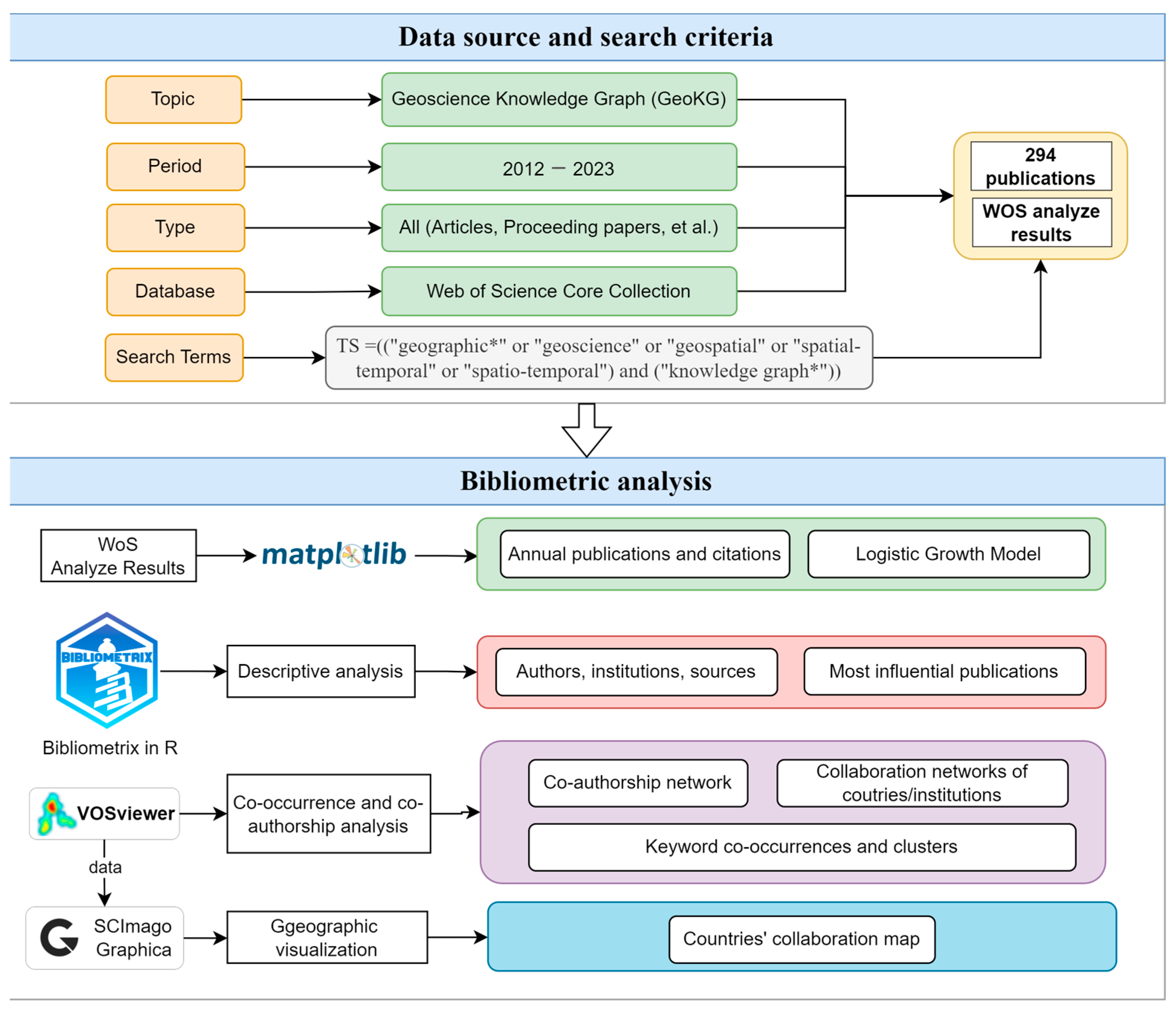
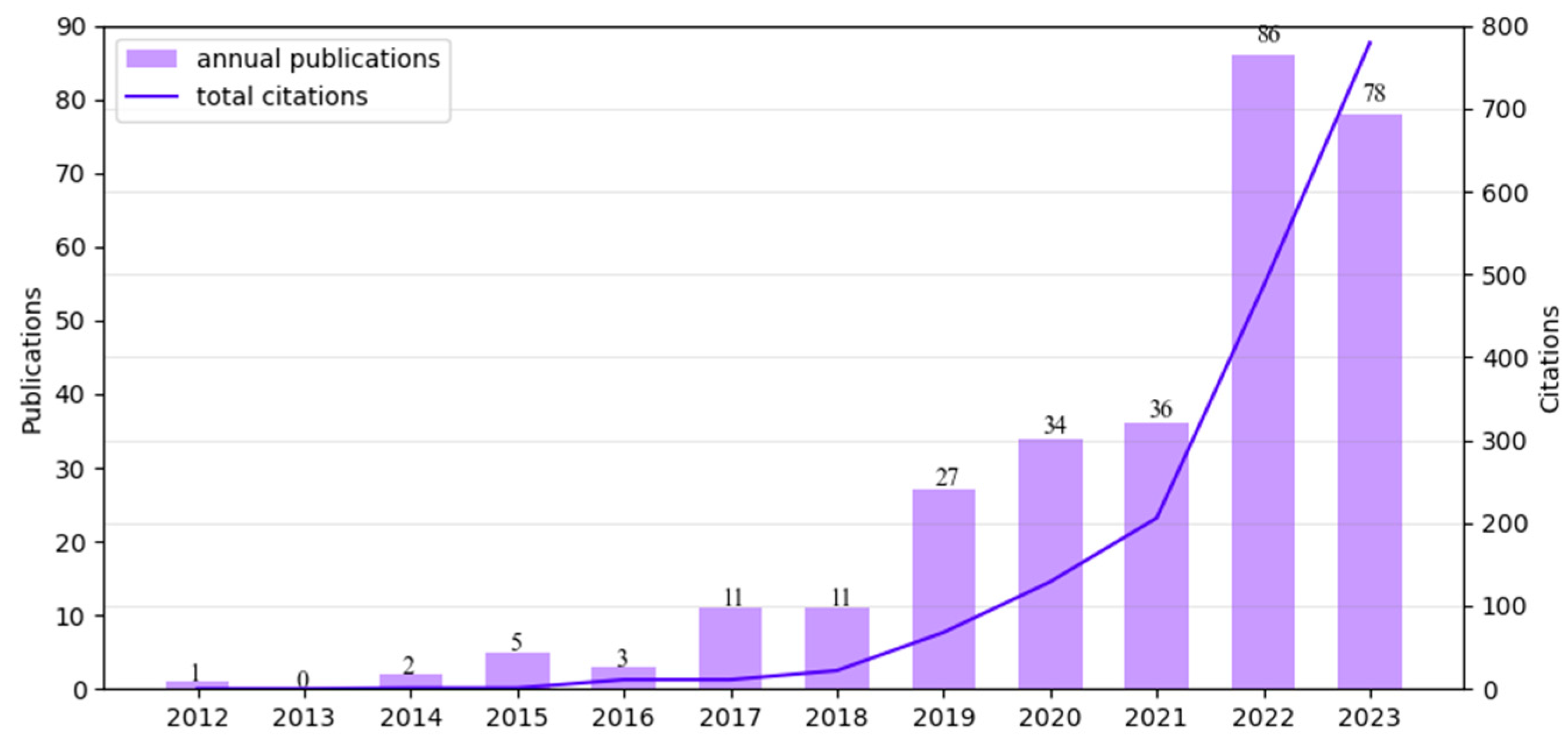

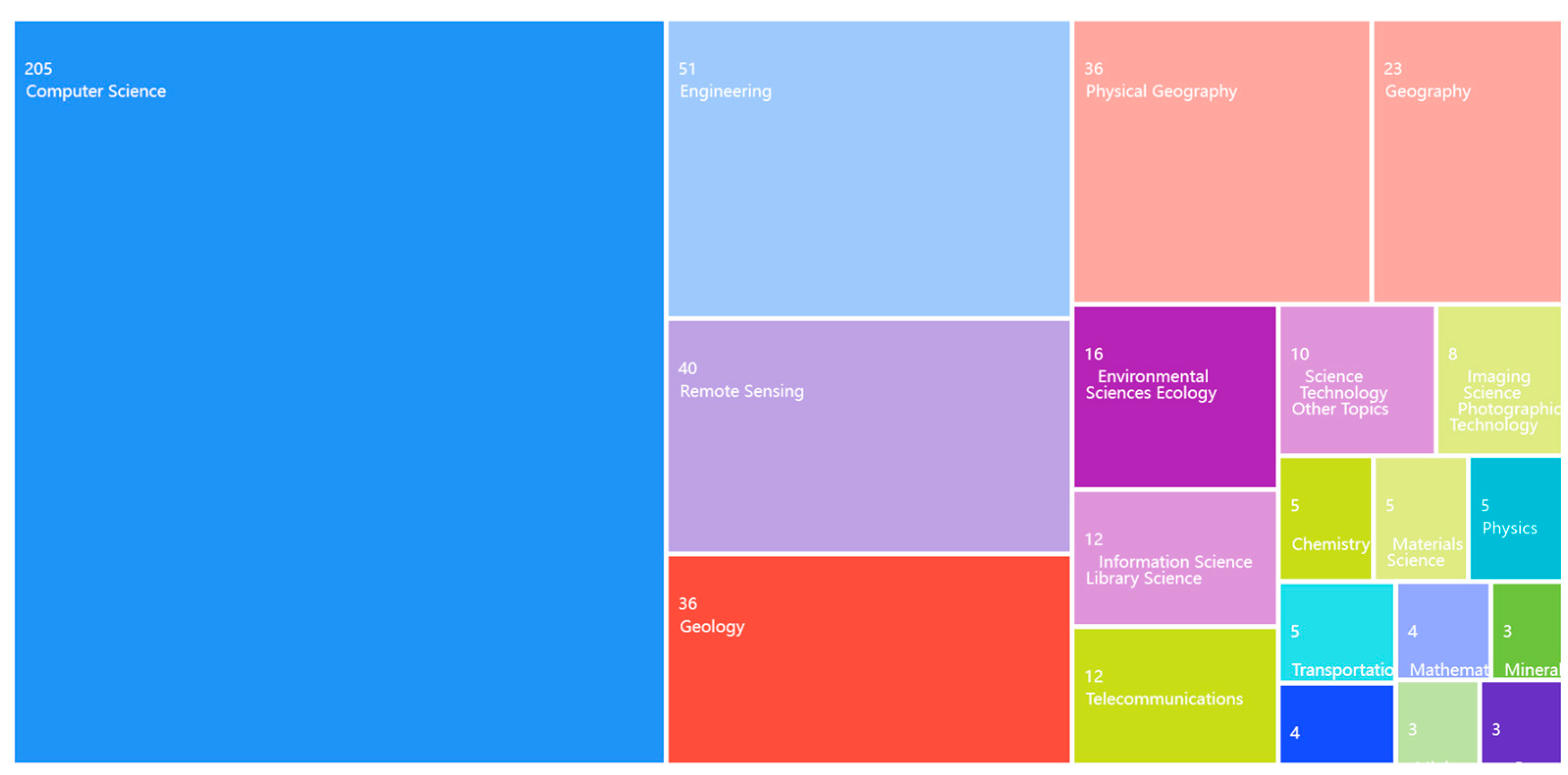

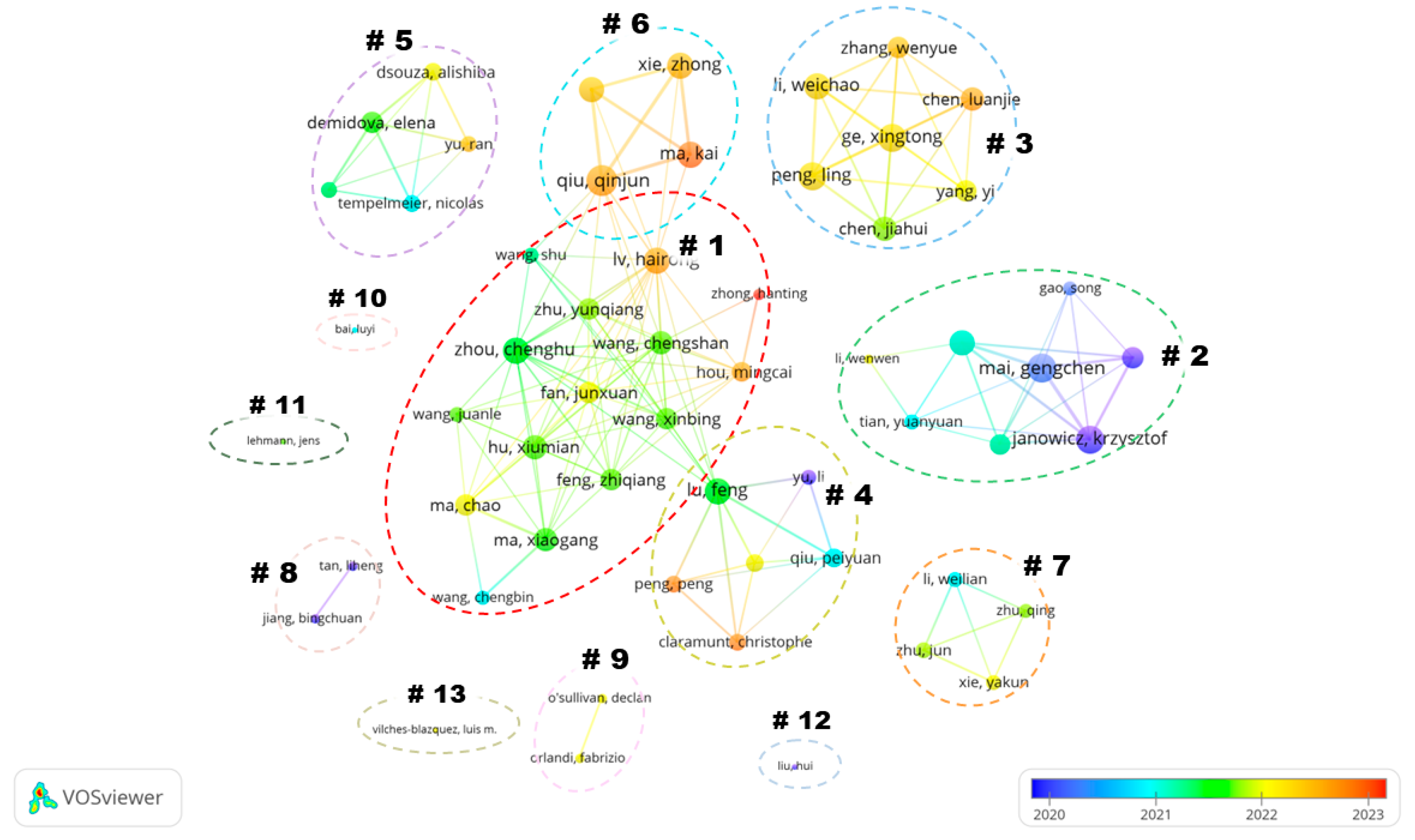
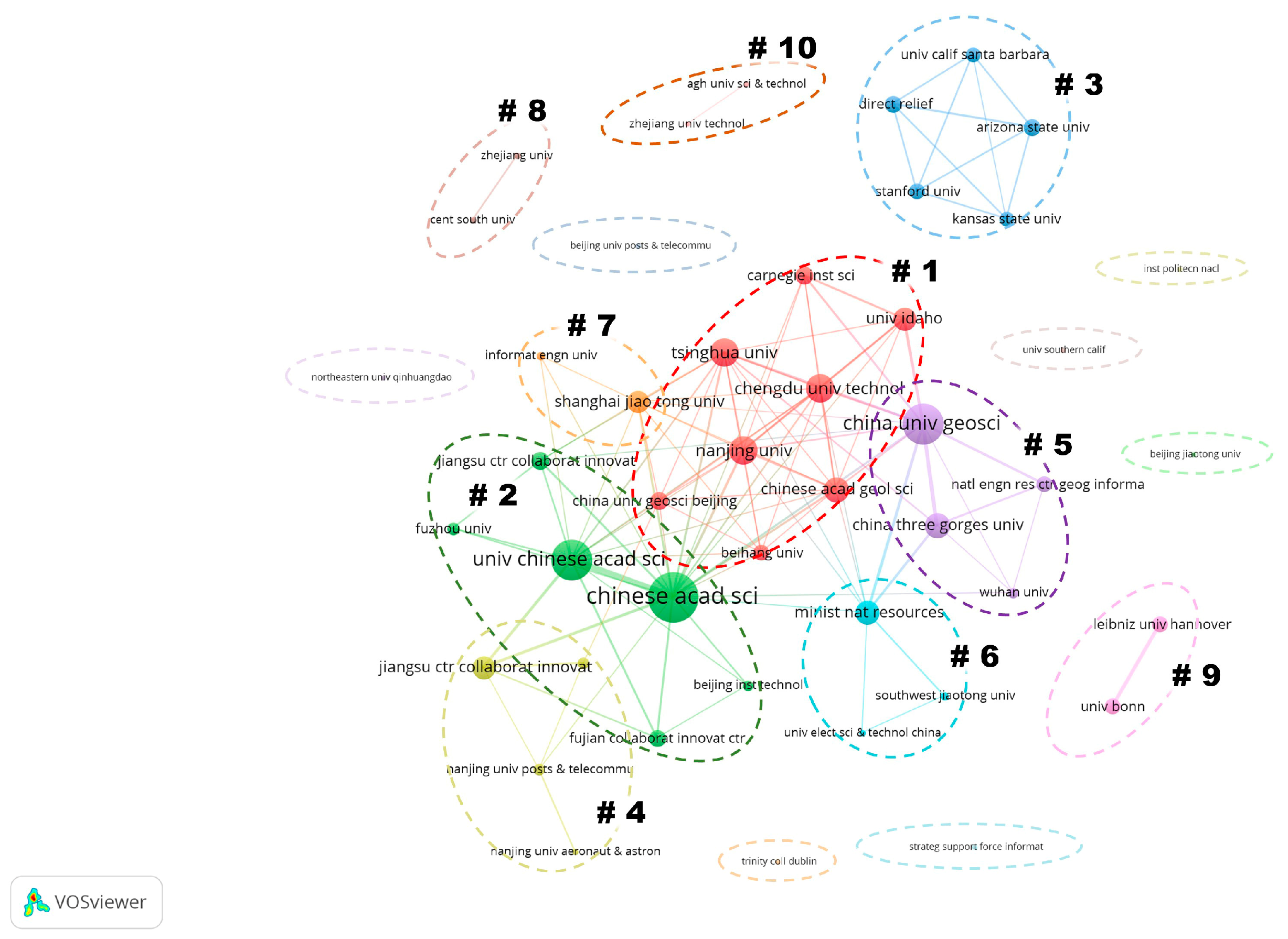
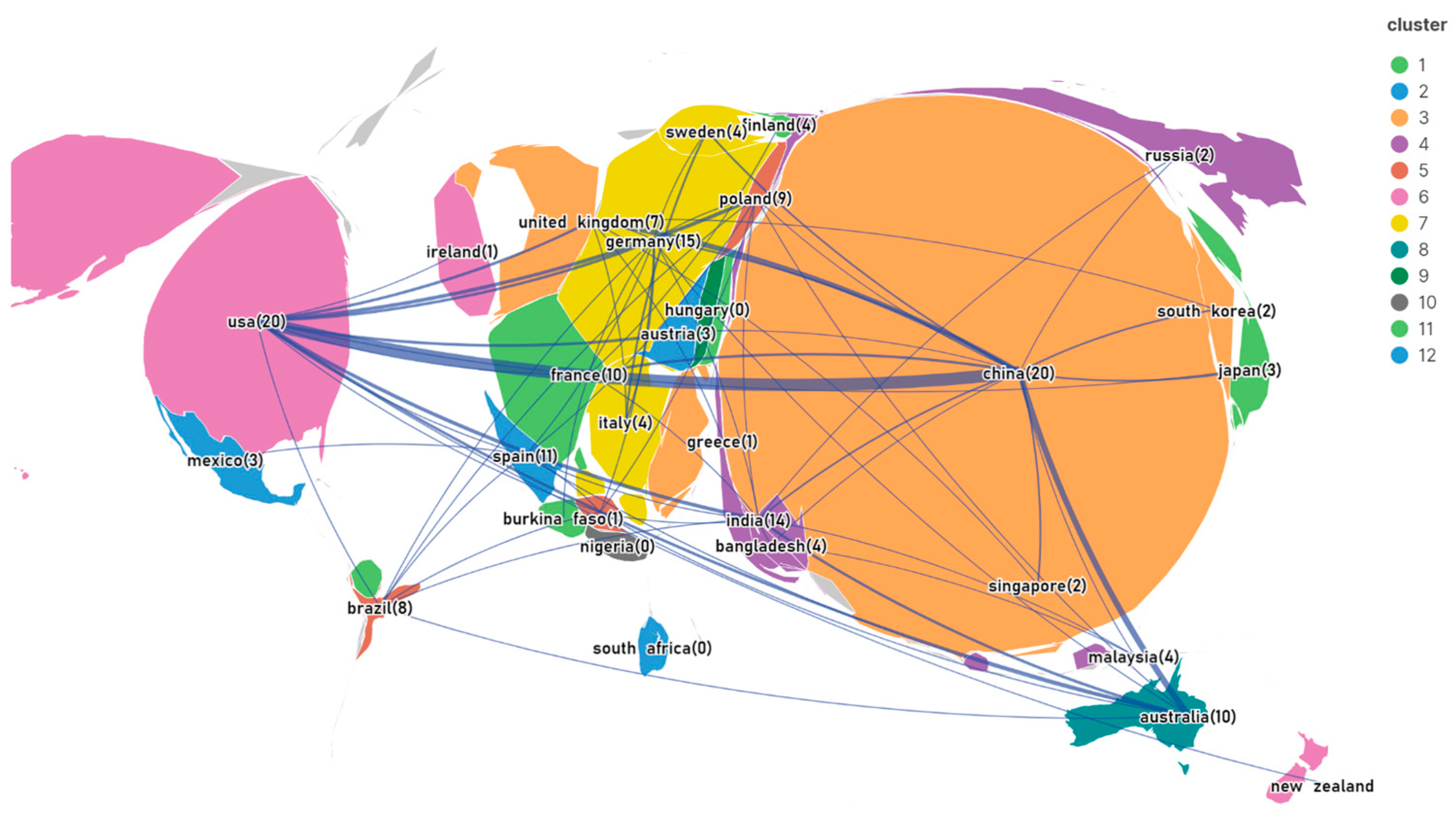

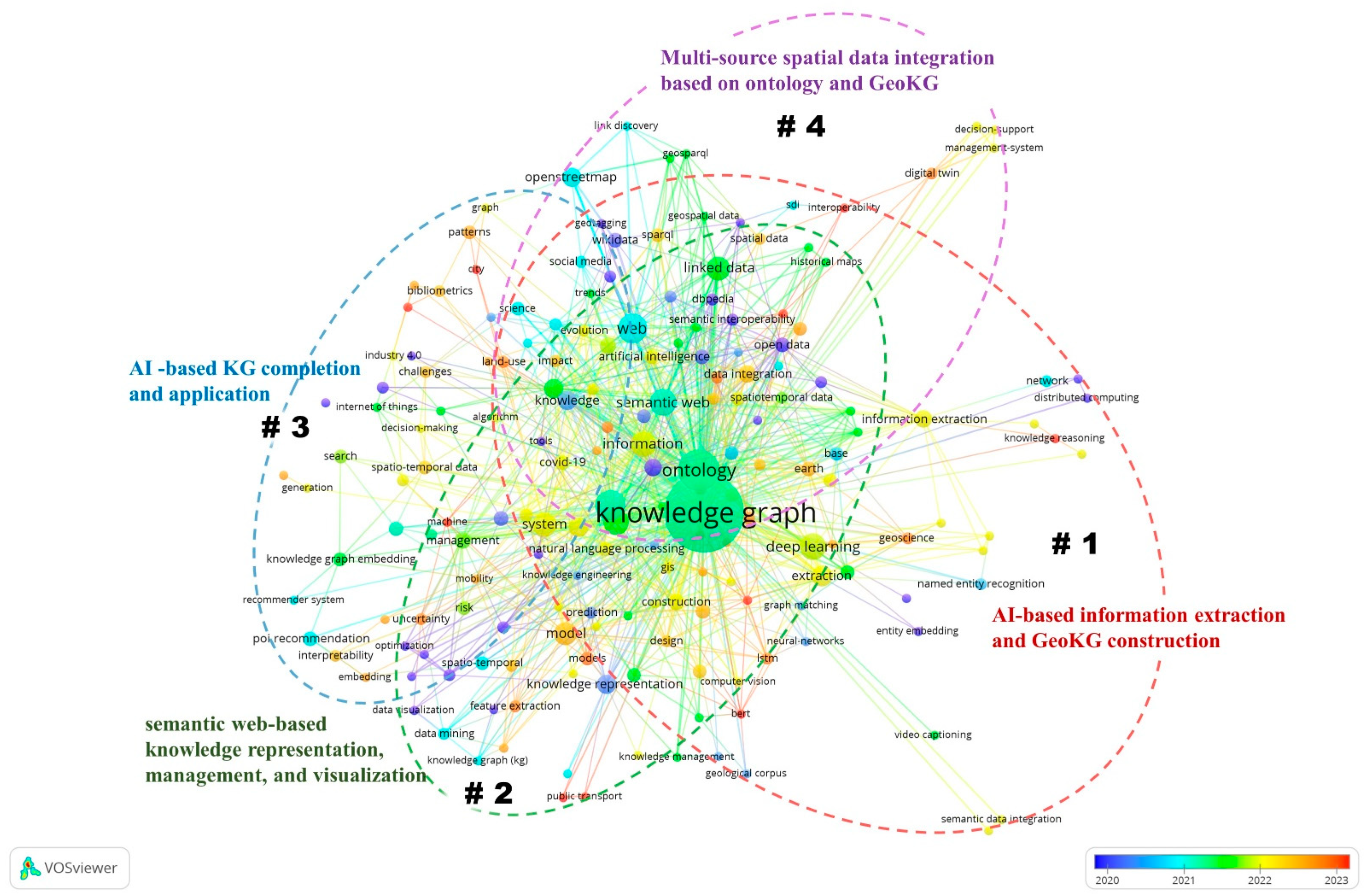
| Rank | Document | Reference | LCS | GCS | Year |
|---|---|---|---|---|---|
| 1 | Wang S, 2019, ISPRS INT J GEO-INF | [29] | 23 | 36 | 2019 |
| 2 | Wang CB, 2018, COMPUT GEOSCI-UK | [40] | 15 | 108 | 2018 |
| 3 | Ma XG, 2020, COMPUT GEOSCI-UK | [39] | 15 | 25 | 2020 |
| 4 | Ma XG, 2022, COMPUT GEOSCI-UK | [8] | 12 | 43 | 2022 |
| 5 | Janowicz K, 2022, AI MAG | [42] | 11 | 21 | 2022 |
| 6 | Zhou CH, 2021, SCI CHINA EARTH SCI | [3] | 10 | 34 | 2021 |
| 7 | Zhang YH, 2020, INT J DIGIT EARTH | [44] | 9 | 23 | 2020 |
| 8 | Tempelmeier N, 2021, FUTURE GENER COMP SY | [43] | 9 | 18 | 2021 |
| 9 | Zheng K, 2022, INT J GEOGR INF SCI | [38] | 9 | 18 | 2022 |
| 10 | Li S, 2018, IEEE ACCESS | [41] | 8 | 46 | 2018 |
| 11 | Wang CS, 2021, NATL SCI REV | [6] | 8 | 41 | 2021 |
| Rank | Source Name | NP | TC | AC | h_Index | IF | PY_Start | JCR Category |
|---|---|---|---|---|---|---|---|---|
| 1 | ISPRS International Journal of Geo-Information | 22 | 133 | 6.05 | 7 | 3.4 | 2015 | Computer Science, Information Systems; Geography, Physical; Remote Sensing |
| 2 | Transactions in GIS | 16 | 89 | 5.57 | 5 | 2.4 | 2019 | Geography |
| 3 | Geoscience Frontiers | 8 | 26 | 3.25 | 3 | 8.9 | 2023 | Geosciences, Multidisciplinary |
| 4 | International Journal of Geographical Information Science | 6 | 71 | 11.83 | 5 | 5.7 | 2015 | Computer Science, Information Systems; Geography; Geography, Physical; Information Science and Library Science |
| 5 | Remote Sensing | 6 | 42 | 7 | 3 | 5 | 2022 | Environmental Sciences; Geosciences, Multidisciplinary; Imaging Science and Photographic Technology; Remote Sensing |
| 6 | International Journal of Digital Earth | 6 | 30 | 5 | 2 | 5.1 | 2020 | Geography, Physical; Remote Sensing |
| 7 | Computers & Geosciences | 5 | 194 | 38.8 | 5 | 4.4 | 2018 | Computer Science, Interdisciplinary Applications; Geosciences, Multidisciplinary |
| 8 | Knowledge Based Systems | 5 | 29 | 5.8 | 4 | 8.8 | 2019 | Computer Science, Artificial Intelligence |
| 9 | IEEE Access | 5 | 59 | 11.8 | 2 | 3.9 | 2018 | Computer Science, Information Systems; Engineering, Electrical and Electronic; Telecommunications |
| Rank | Author | NP | TC | h_Index | g_Index | PY_Start | Current Institution |
|---|---|---|---|---|---|---|---|
| 1 | Janowicz Krzysztof | 12 | 246 | 9 | 12 | 2015 | University of California, Santa Barbara |
| 2 | Mai Gengchen | 10 | 206 | 7 | 10 | 2017 | University of Georgia |
| 3 | Qiu Qinjun | 10 | 75 | 4 | 8 | 2020 | China University of Geosciences, Wuhan |
| 4 | Ma Xiaogang | 8 | 221 | 4 | 8 | 2018 | University of Idaho |
| 5 | Zhu Rui | 8 | 90 | 5 | 8 | 2019 | University of Bristol |
| 6 | Xie Zhong | 8 | 75 | 4 | 8 | 2020 | China University of Geosciences, Wuhan |
| 7 | Demidova Elena | 8 | 46 | 3 | 6 | 2020 | University of Bonn |
| 8 | Ma Kai | 8 | 37 | 3 | 6 | 2022 | China Three Gorges University |
| 9 | Tao Liufeng | 7 | 74 | 4 | 7 | 2020 | China University of Geosciences, Wuhan |
| 10 | Lu Feng | 7 | 33 | 3 | 5 | 2019 | Institute of Geographic Sciences and Natural Resources Research, CAS |
| Rank | Institution | NP | TC | AC | Links | TLS | APY | Country |
|---|---|---|---|---|---|---|---|---|
| 1 | Chinese Academy of Sciences | 31 | 198 | 6.39 | 20 | 61 | 2021.97 | China |
| 2 | China University of Geosciences, Wuhan | 23 | 342 | 14.87 | 13 | 42 | 2021.78 | China |
| 3 | University of Chinese Academy of Sciences | 20 | 127 | 6.35 | 14 | 42 | 2021.9 | China |
| 4 | University of California, Santa Barbara | 13 | 253 | 19.46 | 4 | 7 | 2019.38 | USA |
| 5 | University of Bonn | 12 | 55 | 4.58 | 1 | 8 | 2021.67 | Germany |
| 6 | Tsinghua University | 11 | 64 | 5.82 | 13 | 23 | 2020.82 | China |
| 7 | Leibniz University Hannover | 9 | 49 | 5.44 | 1 | 8 | 2021.11 | Germany |
| 8 | Arizona State University | 8 | 56 | 7 | 4 | 9 | 2021 | USA |
| 9 | Chengdu University of Technology | 8 | 49 | 6.13 | 12 | 22 | 2022.75 | China |
| 10 | China Three Gorges University | 8 | 37 | 4.63 | 5 | 18 | 2022.75 | China |
| 11 | Ministry of Natural Resources of the PRC | 8 | 15 | 1.88 | 9 | 17 | 2022.75 | China |
| 12 | University of Idaho | 8 | 221 | 27.63 | 7 | 16 | 2021.63 | USA |
| 13 | Nanjing University | 7 | 89 | 12.71 | 12 | 22 | 2022.14 | China |
| 14 | Southwest Jiaotong University | 7 | 44 | 6.29 | 2 | 3 | 2021.86 | China |
| 15 | Wuhan University | 6 | 112 | 18.67 | 4 | 4 | 2021.67 | China |
| Rank | Country | NP | TC | SCP | MCP | ACP | MCP_Ratio | Links | TLS |
|---|---|---|---|---|---|---|---|---|---|
| 1 | China | 158 | 905 | 128 | 30 | 5.73 | 0.19 | 20 | 55 |
| 2 | USA | 48 | 464 | 30 | 18 | 9.67 | 0.375 | 20 | 49 |
| 3 | Germany | 18 | 70 | 15 | 3 | 3.89 | 0.167 | 15 | 19 |
| 4 | France | 9 | 26 | 7 | 2 | 2.89 | 0.222 | 10 | 12 |
| 5 | United Kingdom | 8 | 35 | 6 | 2 | 4.38 | 0.25 | 7 | 14 |
| 6 | Italy | 6 | 44 | 4 | 2 | 7.33 | 0.333 | 4 | 6 |
| 7 | Australia | 4 | 130 | 2 | 2 | 32.50 | 0.5 | 10 | 20 |
| 8 | Greece | 4 | 26 | 4 | 0 | 6.50 | 0 | 1 | 1 |
| 9 | Ireland | 4 | 12 | 4 | 0 | 3.00 | 0 | 1 | 1 |
| Cluster | Centered Author * | NA | TLS | NMIA | APY | Color | Country |
|---|---|---|---|---|---|---|---|
| 1 | Zhou, Chenghu | 15 | 22 | 1 | 2021.50 | red | China |
| 2 | Mai, Gengchen | 8 | 26 | 3 | 2020.33 | green | USA |
| 3 | Ge, Xingtong and Peng, Ling | 7 | 25 | 0 | 2022.17 | light blue | China |
| 4 | Lu, Feng | 6 | 22 | 1 | 2021.57 | golden | China |
| 5 | Demidova, Elena | 5 | 15 | 1 | 2021.63 | lilac | Germany |
| 6 | Qiu, Qinjun | 4 | 30 | 4 | 2022.50 | turquoise | China |
| 7 | Zhu, Jun | 4 | 7 | 0 | 2021.80 | orange | China |
| Cluster | Color | Top Keywords (Occurrences, TLS) | Size | ALS | AC | Interpretation |
|---|---|---|---|---|---|---|
| 1 | red | knowledge graph (135, 370), deep learning (15, 38), extraction (5, 45), framework (9, 41), information extraction (7, 21), big data (6, 34), construction (6, 37), artificial intelligence (5, 26), graph neural network (5, 14), natural language processing (5, 14) | 69 | 18.57 | 8.83 | Information extraction and GeoKG construction based on AI |
| 2 | green | semantic web (15, 72), visualization (14, 84), system (13, 61), model (11, 39), knowledge representation (8, 20), semantics (7, 34), management (6, 38), COVID-19 (5, 26), linked open data (5, 16) | 52 | 16.21 | 7.26 | Knowledge representation, management, and visualization |
| 3 | dark cyan | knowledge (8, 29), machine learning (8, 30), knowledge graph completion (5, 8), link prediction (5, 11), poi recommendation (5, 7) | 34 | 7.62 | 6.71 | GeoKG completion and application |
| 4 | purple | ontology (37, 147), GeoKG (20, 51), web (19, 63), information (14, 77), linked data (12, 43), OpenStreetMap (8, 21), data integration (7, 40), earth (5, 37), open data (5, 29), Wikidata (5, 19) | 31 | 24.35 | 6.69 | Multi-source spatial data integration based on GeoKG |
Disclaimer/Publisher’s Note: The statements, opinions and data contained in all publications are solely those of the individual author(s) and contributor(s) and not of MDPI and/or the editor(s). MDPI and/or the editor(s) disclaim responsibility for any injury to people or property resulting from any ideas, methods, instructions or products referred to in the content. |
© 2024 by the authors. Licensee MDPI, Basel, Switzerland. This article is an open access article distributed under the terms and conditions of the Creative Commons Attribution (CC BY) license (https://creativecommons.org/licenses/by/4.0/).
Share and Cite
Hou, Z.-W.; Liu, X.; Zhou, S.; Jing, W.; Yang, J. Bibliometric Analysis on the Research of Geoscience Knowledge Graph (GeoKG) from 2012 to 2023. ISPRS Int. J. Geo-Inf. 2024, 13, 255. https://doi.org/10.3390/ijgi13070255
Hou Z-W, Liu X, Zhou S, Jing W, Yang J. Bibliometric Analysis on the Research of Geoscience Knowledge Graph (GeoKG) from 2012 to 2023. ISPRS International Journal of Geo-Information. 2024; 13(7):255. https://doi.org/10.3390/ijgi13070255
Chicago/Turabian StyleHou, Zhi-Wei, Xulong Liu, Shengnan Zhou, Wenlong Jing, and Ji Yang. 2024. "Bibliometric Analysis on the Research of Geoscience Knowledge Graph (GeoKG) from 2012 to 2023" ISPRS International Journal of Geo-Information 13, no. 7: 255. https://doi.org/10.3390/ijgi13070255
APA StyleHou, Z.-W., Liu, X., Zhou, S., Jing, W., & Yang, J. (2024). Bibliometric Analysis on the Research of Geoscience Knowledge Graph (GeoKG) from 2012 to 2023. ISPRS International Journal of Geo-Information, 13(7), 255. https://doi.org/10.3390/ijgi13070255










